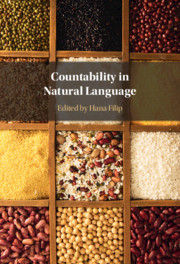Book contents
- Countability in Natural Language
- Countability in Natural Language
- Copyright page
- Contents
- Contributors
- Preface
- Introduction
- 1 Proportional Many/Much and Most
- 2 Quantity Systems and the Count/Mass Distinction
- 3 Counting Aggregates, Groups and Kinds: Countability from the Perspective of a Morphologically Complex Language
- 4 Individuating Matter over Time
- 5 Reduplication as Summation
- 6 Iceberg Semantics for Count Nouns and Mass Nouns: How Mass Counts
- 7 Indexical Inference: Counting and Measuring in Context
- 8 Counting and Measuring and Approximation
- 9 The Count/Mass Distinction for Granular Nouns
- Index
- References
7 - Indexical Inference: Counting and Measuring in Context
Published online by Cambridge University Press: 11 June 2021
- Countability in Natural Language
- Countability in Natural Language
- Copyright page
- Contents
- Contributors
- Preface
- Introduction
- 1 Proportional Many/Much and Most
- 2 Quantity Systems and the Count/Mass Distinction
- 3 Counting Aggregates, Groups and Kinds: Countability from the Perspective of a Morphologically Complex Language
- 4 Individuating Matter over Time
- 5 Reduplication as Summation
- 6 Iceberg Semantics for Count Nouns and Mass Nouns: How Mass Counts
- 7 Indexical Inference: Counting and Measuring in Context
- 8 Counting and Measuring and Approximation
- 9 The Count/Mass Distinction for Granular Nouns
- Index
- References
Summary
This chapter analyses how we give linguistic expression to counting as a cognitive process of interpretation in context with a focus on the interaction between aspectual adverbs and phrases with numerical DPs. For example, the use of already or no longer in there are already/no longer three students here conveys the speaker’s knowledge of the recent past of the described situation and gives rise to indexical inferences, for example, that three students were here. In order to capture these indexical inferences, ter Meulen proposes a DRT analysis that models both the information that utterances presuppose in the common ground and the inference triggered by the aspectual adverb in the context. Ter Meulen then considers how this approach could be extended to polar question uses of aspectual adverbs (Still?/Already?), and discusses the interesting and intricate differences between uses of aspectual adverbs and numerical DPs cross-linguistically.
- Type
- Chapter
- Information
- Countability in Natural Language , pp. 199 - 216Publisher: Cambridge University PressPrint publication year: 2021

